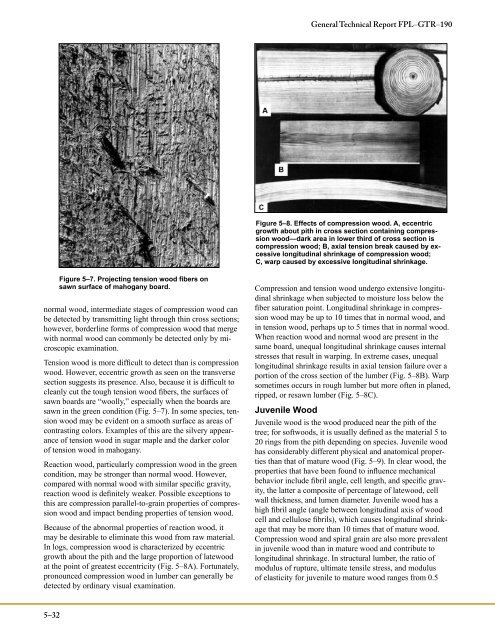Wood Handbook, Chapter 05: Mechanical Properties of Wood
Wood Handbook, Chapter 05: Mechanical Properties of Wood
Wood Handbook, Chapter 05: Mechanical Properties of Wood
You also want an ePaper? Increase the reach of your titles
YUMPU automatically turns print PDFs into web optimized ePapers that Google loves.
normal wood, intermediate stages <strong>of</strong> compression wood can<br />
be detected by transmitting light through thin cross sections;<br />
however, borderline forms <strong>of</strong> compression wood that merge<br />
with normal wood can commonly be detected only by microscopic<br />
examination.<br />
Tension wood is more difficult to detect than is compression<br />
wood. However, eccentric growth as seen on the transverse<br />
section suggests its presence. Also, because it is difficult to<br />
cleanly cut the tough tension wood fibers, the surfaces <strong>of</strong><br />
sawn boards are “woolly,” especially when the boards are<br />
sawn in the green condition (Fig. 5–7). In some species, tension<br />
wood may be evident on a smooth surface as areas <strong>of</strong><br />
contrasting colors. Examples <strong>of</strong> this are the silvery appearance<br />
<strong>of</strong> tension wood in sugar maple and the darker color<br />
<strong>of</strong> tension wood in mahogany.<br />
Reaction wood, particularly compression wood in the green<br />
condition, may be stronger than normal wood. However,<br />
compared with normal wood with similar specific gravity,<br />
reaction wood is definitely weaker. Possible exceptions to<br />
this are compression parallel-to-grain properties <strong>of</strong> compression<br />
wood and impact bending properties <strong>of</strong> tension wood.<br />
Because <strong>of</strong> the abnormal properties <strong>of</strong> reaction wood, it<br />
may be desirable to eliminate this wood from raw material.<br />
In logs, compression wood is characterized by eccentric<br />
growth about the pith and the large proportion <strong>of</strong> latewood<br />
at the point <strong>of</strong> greatest eccentricity (Fig. 5–8A). Fortunately,<br />
pronounced compression wood in lumber can generally be<br />
detected by ordinary visual examination.<br />
5–32<br />
Figure 5–7. Projecting tension wood fibers on<br />
sawn surface <strong>of</strong> mahogany board.<br />
Figure 5–8. Effects <strong>of</strong> compression wood. A, eccentric<br />
growth about pith in cross section containing compression<br />
wood—dark area in lower third <strong>of</strong> cross section is<br />
compression wood; B, axial tension break caused by excessive<br />
longitudinal shrinkage <strong>of</strong> compression wood;<br />
C, warp caused by excessive longitudinal shrinkage.<br />
Compression and tension wood undergo extensive longitudinal<br />
shrinkage when subjected to moisture loss below the<br />
fiber saturation point. Longitudinal shrinkage in compression<br />
wood may be up to 10 times that in normal wood, and<br />
in tension wood, perhaps up to 5 times that in normal wood.<br />
When reaction wood and normal wood are present in the<br />
same board, unequal longitudinal shrinkage causes internal<br />
stresses that result in warping. In extreme cases, unequal<br />
longitudinal shrinkage results in axial tension failure over a<br />
portion <strong>of</strong> the cross section <strong>of</strong> the lumber (Fig. 5–8B). Warp<br />
sometimes occurs in rough lumber but more <strong>of</strong>ten in planed,<br />
ripped, or resawn lumber (Fig. 5–8C).<br />
Juvenile <strong>Wood</strong><br />
General Technical Report FPL–GTR–190<br />
Juvenile wood is the wood produced near the pith <strong>of</strong> the<br />
tree; for s<strong>of</strong>twoods, it is usually defined as the material 5 to<br />
20 rings from the pith depending on species. Juvenile wood<br />
has considerably different physical and anatomical properties<br />
than that <strong>of</strong> mature wood (Fig. 5–9). In clear wood, the<br />
properties that have been found to influence mechanical<br />
behavior include fibril angle, cell length, and specific gravity,<br />
the latter a composite <strong>of</strong> percentage <strong>of</strong> latewood, cell<br />
wall thickness, and lumen diameter. Juvenile wood has a<br />
high fibril angle (angle between longitudinal axis <strong>of</strong> wood<br />
cell and cellulose fibrils), which causes longitudinal shrinkage<br />
that may be more than 10 times that <strong>of</strong> mature wood.<br />
Compression wood and spiral grain are also more prevalent<br />
in juvenile wood than in mature wood and contribute to<br />
longitudinal shrinkage. In structural lumber, the ratio <strong>of</strong><br />
modulus <strong>of</strong> rupture, ultimate tensile stress, and modulus<br />
<strong>of</strong> elasticity for juvenile to mature wood ranges from 0.5

















